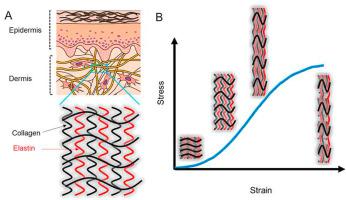Biomaterials ( IF 12.8 ) Pub Date : 2020-11-27 , DOI: 10.1016/j.biomaterials.2020.120558 Abbas Shafiee , Amanda S. Cavalcanti , Navid T. Saidy , Dominik Schneidereit , Oliver Friedrich , Akhilandeshwari Ravichandran , Elena M De-Juan-Pardo , Dietmar W. Hutmacher

|
Biomimetically designed medical-grade polycaprolactone (mPCL) dressings are 3D-printed with pore architecture and anisotropic mechanical characteristics that favor skin wound healing with reduced scarring. Melt electrowritten mPCL dressings are seeded with human gingival tissue multipotent mesenchymal stem/stromal cells and cryopreserved using a clinically approved method. The regenerative potential of fresh or frozen cell-seeded mPCL dressing is compared in a splinted full-thickness excisional wound in a rat model over six weeks. The application of 3D-printed mPCL dressings decreased wound contracture and significantly improved skin regeneration through granulation and re-epithelialization compared to control groups. Combining 3D-printed biomimetic wound dressings and precursor cell delivery enhances physiological wound closure with reduced scar tissue formation.
中文翻译:

3D打印仿生伤口敷料与成人干细胞疗法的融合
仿生设计的医学级聚己内酯(mPCL)敷料经过3D打印,具有毛孔结构和各向异性的机械特性,有利于伤口愈合并减少疤痕。用人类牙龈组织多能间充质干细胞/基质细胞接种融化的电化mPCL敷料,并使用临床认可的方法冷冻保存。在大鼠模型的夹板全层切除伤口中,经过六周,比较了新鲜或冷冻的接种有细胞的mPCL敷料的再生潜力。与对照组相比,通过3D打印的mPCL敷料的应用可以减少伤口挛缩并通过制粒和重新上皮形成显着改善皮肤再生。











































 京公网安备 11010802027423号
京公网安备 11010802027423号